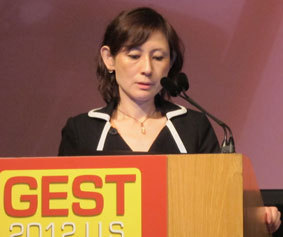
Miyuki Sone, from the National Cancer Center, Japan made the case for gelfoam remaining an essential embolic material in the future at GEST 2012 US (May, New York, USA).
Sone told delegates that in many ways gelfoam was an ideal embolic material. “In terms of efficacy it results in reliable occlusion of target vessels. It also has an acceptable safety profile with a minimal inflammatory response. There is sufficient evidence to back both these claims. In terms of technique, gelfoam is easy to prepare and inject and its size can be controlled by the operator. With regard to socioeconomic factors, it is readily available and inexpensive,” she said.
Gelfoam is available in a variety of shapes and sizes including sheets, spherical particles and cubic or pre-shaped forms.
The factors to consider when choosing an embolic material are the target vessels, the disease condition, and the types of embolic material available.
Sone said, “One of the advantages of sheet gelatin is that it can be prepared into a range of sizes depending on how it is prepared. Gelfoam can be prepared as torpedoe, slurries, cut pieces and by pumping. The important clinical/pathological features of any embolic are recanalisation, resorption and inflammation; with Gelfoam, recanalisation can take place in the time frame between hours to weeks. It can also degrade within days to months,” she said.
Sone noted that with regard to the common disease conditions treated with gelfoam, in the case of hepatocellular carcinoma, the preparation of the embolic is by cutting or pumping to achieve a small size. “Gelfoam has been used in the meta-analysis by Lllovet anfd Bruix in Hepatology in 2003,” she said. With postpartum haemorrhage, the embolic is cut and is considered a standard embolic worlwide, she said. Sone also noted that cut gelfoam, which is a medium-sized embolic material and mainly used in Japan, had the same clinical efficacy as other embolic materials when used in the treatment of uterine fibroid embolization. She noted that a study by Iwamoto et al, published in 2006, estimated that gelfoam was used in 97% of uterine artery embolization cases in Japan. “The clinical success has been demonstrated as being 72–100% and menstruation is maintained in 91–100% of cases. Also pregnancy, when desired, is achieved with the embolic in 69–100% of cases, she said.
Sone also told delegates that large gelatin sponge particles as formed by torpedo methods was used in tract embolization to avoid bleeding after percutaneous approach for portal vein intervention and biliary intervention.
“If you have to go to a field hospital alone as an interventional radiologist with minimal material, which embolic material would you choose?” Sone asked delegates. She said the answer should be gelfoam because gelatin sponge is the most flexible embolic material that can be used in various different situations. “Gelatin sponge is flexible in size, has characteristic resorption and recanalisation and is accessible and inexpensive,” she concluded.












